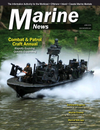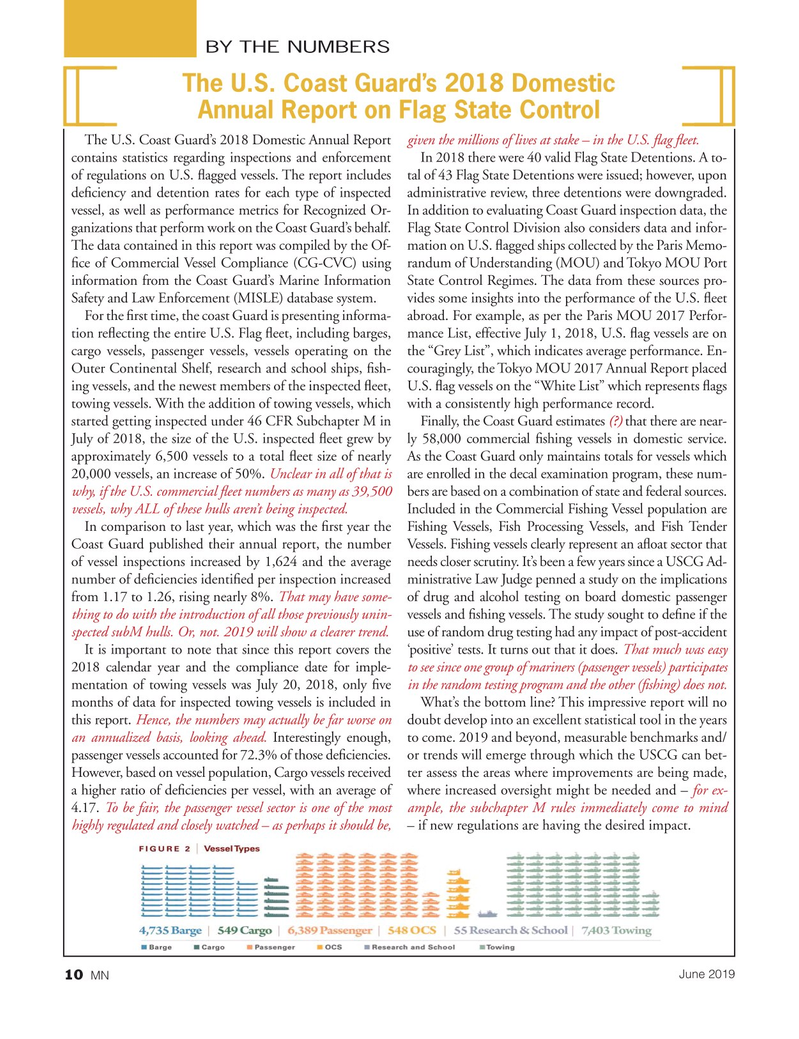
Page 10: of Marine News Magazine (June 2019)
Combat & Patrol Craft Annual
Read this page in Pdf, Flash or Html5 edition of June 2019 Marine News Magazine
BY THE NUMBERS
The U.S. Coast Guard’s 2018 Domestic
Annual Report on Flag State Control
The U.S. Coast Guard’s 2018 Domestic Annual Report given the millions of lives at stake – in the U.S. ? ag ? eet.
contains statistics regarding inspections and enforcement In 2018 there were 40 valid Flag State Detentions. A to- of regulations on U.S. ? agged vessels. The report includes tal of 43 Flag State Detentions were issued; however, upon de? ciency and detention rates for each type of inspected administrative review, three detentions were downgraded. vessel, as well as performance metrics for Recognized Or- In addition to evaluating Coast Guard inspection data, the ganizations that perform work on the Coast Guard’s behalf. Flag State Control Division also considers data and infor-
The data contained in this report was compiled by the Of- mation on U.S. ? agged ships collected by the Paris Memo- ? ce of Commercial Vessel Compliance (CG-CVC) using randum of Understanding (MOU) and Tokyo MOU Port information from the Coast Guard’s Marine Information State Control Regimes. The data from these sources pro-
Safety and Law Enforcement (MISLE) database system. vides some insights into the performance of the U.S. ? eet
For the ? rst time, the coast Guard is presenting informa- abroad. For example, as per the Paris MOU 2017 Perfor- tion re? ecting the entire U.S. Flag ? eet, including barges, mance List, effective July 1, 2018, U.S. ? ag vessels are on cargo vessels, passenger vessels, vessels operating on the the “Grey List”, which indicates average performance. En-
Outer Continental Shelf, research and school ships, ? sh- couragingly, the Tokyo MOU 2017 Annual Report placed ing vessels, and the newest members of the inspected ? eet, U.S. ? ag vessels on the “White List” which represents ? ags towing vessels. With the addition of towing vessels, which with a consistently high performance record.
started getting inspected under 46 CFR Subchapter M in Finally, the Coast Guard estimates (?) that there are near-
July of 2018, the size of the U.S. inspected ? eet grew by ly 58,000 commercial ? shing vessels in domestic service. approximately 6,500 vessels to a total ? eet size of nearly As the Coast Guard only maintains totals for vessels which 20,000 vessels, an increase of 50%. Unclear in all of that is are enrolled in the decal examination program, these num- why, if the U.S. commercial ? eet numbers as many as 39,500 bers are based on a combination of state and federal sources. vessels, why ALL of these hulls aren’t being inspected. Included in the Commercial Fishing Vessel population are
In comparison to last year, which was the ? rst year the Fishing Vessels, Fish Processing Vessels, and Fish Tender
Coast Guard published their annual report, the number Vessels. Fishing vessels clearly represent an a? oat sector that of vessel inspections increased by 1,624 and the average needs closer scrutiny. It’s been a few years since a USCG Ad- number of de? ciencies identi? ed per inspection increased ministrative Law Judge penned a study on the implications from 1.17 to 1.26, rising nearly 8%. That may have some- of drug and alcohol testing on board domestic passenger thing to do with the introduction of all those previously unin- vessels and ? shing vessels. The study sought to de? ne if the spected subM hulls. Or, not. 2019 will show a clearer trend. use of random drug testing had any impact of post-accident
It is important to note that since this report covers the ‘positive’ tests. It turns out that it does. That much was easy 2018 calendar year and the compliance date for imple- to see since one group of mariners (passenger vessels) participates mentation of towing vessels was July 20, 2018, only ? ve in the random testing program and the other (? shing) does not.
months of data for inspected towing vessels is included in What’s the bottom line? This impressive report will no this report. Hence, the numbers may actually be far worse on doubt develop into an excellent statistical tool in the years an annualized basis, looking ahead. Interestingly enough, to come. 2019 and beyond, measurable benchmarks and/ passenger vessels accounted for 72.3% of those de? ciencies. or trends will emerge through which the USCG can bet-
However, based on vessel population, Cargo vessels received ter assess the areas where improvements are being made, a higher ratio of de? ciencies per vessel, with an average of where increased oversight might be needed and – for ex- 4.17. To be fair, the passenger vessel sector is one of the most ample, the subchapter M rules immediately come to mind highly regulated and closely watched – as perhaps it should be, – if new regulations are having the desired impact.
June 2019 10 MN

 9
9

 11
11
